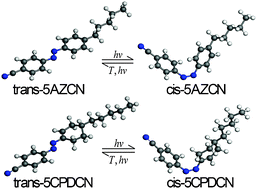Molecular dynamics simulation study on the isomerization and molecular orientation of liquid crystals formed by azobenzene and (1-cyclohexenyl)phenyldiazene†
Abstract
Atomistic molecular dynamics simulations have are used to investigate the liquid crystal systems based on


 Please wait while we load your content...
Please wait while we load your content...